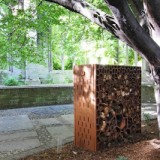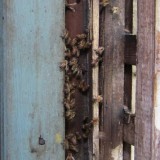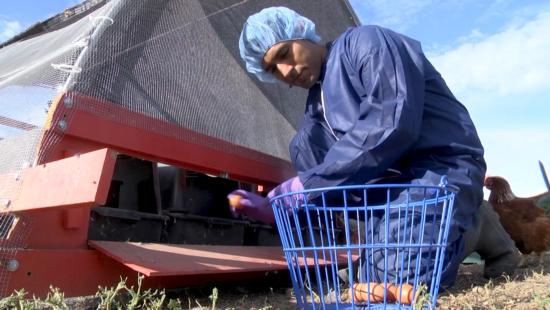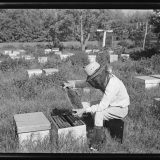Last week, along with two other “backwards beekeepers” Russ and Sue, we relocated a hive of bees that had taken up residence in a garage wall in East Hollywood. It was a “cut-out” in beekeeping parlance. The property owners did not want to exterminate the hive and we were able to give them a new home in Sue’s idyllic garden. Backwards Beekeeping guru Kirk Anderson sent us some tips via email. It’s Kirk’s view that feral bees have more robust immune systems than the pedigreed bees that most beekeepers order through the mail. So with good intentions we got about to, as Kirk puts it, “save the world.” Here’s how we did it:
Kirk told us to smoke the hive when we got there and smoke again when needed. Smoke makes the bees think their house is on fire and they rush to stock up on honey. Preoccupied with their sweet food stockpile they ignore the homo sapiens tearing their house apart. Russ got one sting, but the hive was pretty calm under the circumstances.
Next, we got all our tools ready and suited up in our white bee suits. A cut-out is a delicate combination of building demolition and surgery on a living entity. Like surgery, once you start you can’t stop. With a long butcher knife and some crowbars we peeled back the paneling to reveal . . . more paneling underneath! Thankfully it was ancient fiberboard that disintegrated as we tugged on it. The comb was not attached to the panelling and we were able to easily access the hive. Kirk had warned us to have the butcher knife ready in case we had to separate comb from the wall as we peeled it back. With the wall off we could see a mass of several thousand bees who had neatly built comb between two studs.
Russ and Sue then began to carefully cut out the comb from the wall cavity with the butcher knife and put it into wooden frames, using string to tie it in place (see Kirk doing this at the end of this Backwards Beekeeping TV episode). We focused on saving the comb with brood (bee larvae). These frames were then placed into a “nuc” box, a cardboard box that holds five frames in which we could transport the bees to their new home. We also had two garbage bags: one for empty comb and the other for honey comb to feed back to the bees once they got to Sue’s garden. The next time I do this I’m going to get some buckets for this purpose as the trash bags tend get stuck together with honey. Another lesson I learned is to bring a tarp. Taking a hive out of a wall leaves a huge mess of spilled honey, construction debris and dead bees.
Once we had the brood comb in the nuc box we noticed worker bees returning from field massing where their hive used to be. We put the nuc box with the frames of brood in it next to the wall and took a break. Russ gave Kirk a call and he suggested we spray the mass of workers with sugar water and use our bee brush to push them into a dust pan. The sugar water occupies the bees with cleaning themselves and makes them easier to move. Once in the dust pan they are easy to dump into the nuc box where, we hoped, the queen had taken up residence.
After scooping up as many workers as we could we taped up the nuc box and got ready to put it in the back of Sue’s hatchback. Recalling the story of a friend of a friend who had a nuc box full of bees overturn while driving a sedan, Sue and I decided to drive the short distance home wearing our bee suits (a truck would be handy here!). Even on the streets of freaky East Hollywood, the sight of two bee suit clad folks in a car attracted curious stares and laughter. During the short drive I noticed, through the screen of my veil, public access TV star Francine Dancer, in her wheelchair, going through a box of junk on Virgil. It’s moments like these that reveal Los Angeles as far more like the magical realism of a Gabriel Garcia Marquez novel than the celebrity spectacle the media disseminates.
When we got back to Sue’s garden we put the frames into a hive box and dumped the loose bees in. While we won’t know for a while if the hive will take to its new home, we all felt a great sense of accomplishment. Hopefully, other urbanites around the world will take up beekeeping and put more exterminators out of work.
For more info on Kirk Anderson’s natural beekeeping methods see www.beehuman.blogspot.com.
Got a beehive that needs to be removed from your LA area residence? Get in touch with Kirk at kirksurbanbees.com.






This was invigorating to read. What a cool story, well told. We had a swarm of bees in our yard this summer. Thankfully they took up residence in our willow tree instead of our garage and did our plum and pear trees some good!
Well done! We hope you keep us updated on the status of the hive in its new home.
Awesome post!
Hive update: So far, so good, knock wood. I have the garage band of bees in a medium super (hive box)—the six full frames we extracted, plus four empty frames. This is topped by another (empty) super so that there is room under the lid for the chunks of honey comb taken from their wall hive. I am feeding this back to them so they will have sustenance while acclimating to their new surroundings. Which they seem to be doing—they are already foraging in the big world (like my other hive, they all seem to fly off in the direction of the Homegrown Evolution homestead across the canyon—so much for my idyllic garden!) They are also chewing off and dragging out the string we used to tie in the comb to the frames, which means they are repairing their desecrated hive, and they’ve built a little bit of comb in the empty frames—all good signs. I won’t inspect them thoroughly for another week or two, as they’ve been through a lot; but eventually I will look to see if there is any evidence that we got the queen, or that they’re making another one. The other hive is pretty self-sufficient, so I don’t think they are stealing any honey from the new kids. This is so much fun!!
Amazing! I was looking forward to reading this post! Thank you!
Two days ago I saw some stray bees in Jens yard that hovered at the same spot where the hive used to be and I was wondering how the transferred bees were doing. Great to hear that all is good. Looking forward to more on this. 🙂
Thanks for giving the bees a good home sue. I hope they have their queen or figure on making a new one. They are sweet bees.